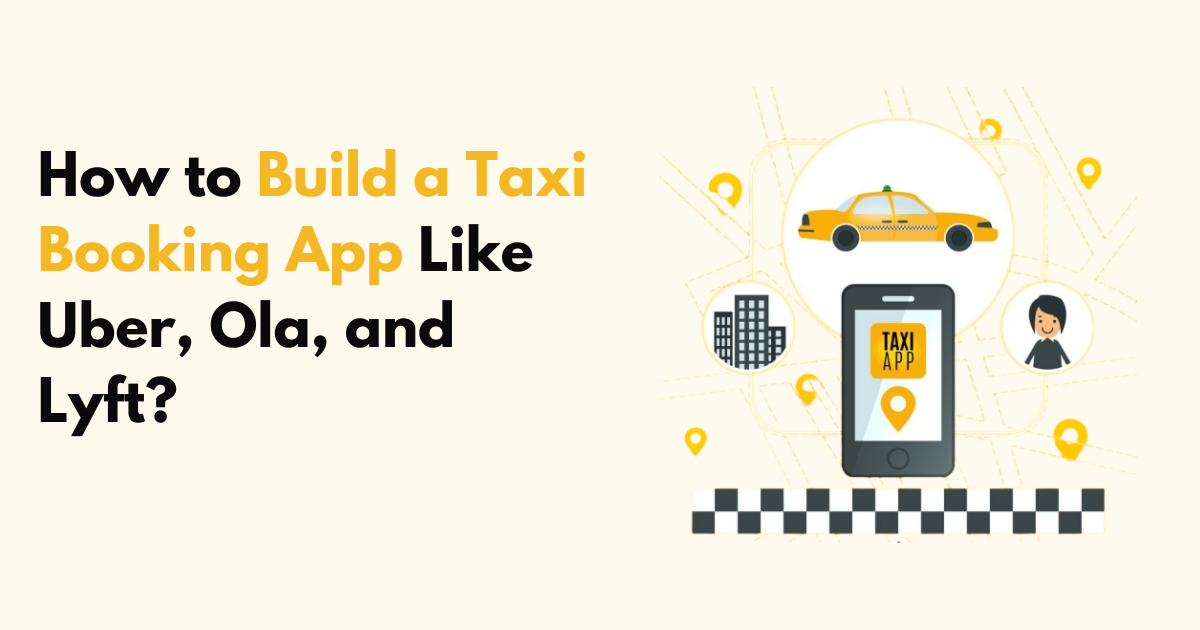How to Build a Taxi Booking App Like Uber, Ola, and Lyft?

The rise of ride-hailing services such as Uber, Ola, and Lyft has transformed the transportation industry. As the demand for on-demand transportation continues to grow, many entrepreneurs and businesses are exploring opportunities to develop their own taxi booking apps to capitalize on this booming market. If you’re considering building a taxi booking app like Uber, Ola, and Lyft, this guide will walk you through the key steps, important features, and crucial factors, including the taxi booking app development cost.
In this article, we’ll cover everything from the on-demand taxi software solution to how you can create an on-demand taxi booking app solution that stands out in a competitive market.
The Rising Demand for Taxi Booking Apps
The success of taxi booking apps like Uber, Ola, and Lyft has revolutionized the transportation sector. Consumers now expect convenience and reliability when booking a ride, leading to the rapid adoption of on-demand taxi app solutions.
The on-demand taxi business model is growing rapidly across the globe, and this trend shows no signs of slowing down. People now prefer the flexibility and affordability of these platforms compared to traditional taxi services. As an entrepreneur or business looking to enter the ride-hailing market, you have an exciting opportunity to tap into this high-demand industry.
Key Features of a Taxi Booking App Like Uber, Ola & Lyft
Before diving into the taxi booking app development cost and the technical aspects, it’s important to understand the essential features that your on-demand taxi app must have. These features will help ensure your app is functional, user-friendly, and competitive with major players like Uber, Ola, and Lyft.
1. User Panel Features
The user panel is where passengers will interact with your app. Here are some key features that should be included:
User Registration & Profile Management: Users should be able to register with their email or social media accounts, and update their profile easily.
Ride Booking: This is the core feature of the app. The user should be able to select their ride type, enter the pickup location, and set the destination. Real-time ride tracking is also a must.
Payment Integration: Provide multiple payment options such as credit/debit cards, wallets, or cash on delivery.
Ride History and Receipt: Users should be able to access their ride history and download receipts for their trips.
Rating and Reviews: After the ride is completed, users should be able to rate the driver and leave reviews for future users to benefit from.
2. Driver Panel Features
For the drivers, the app should have an easy-to-use interface to manage their rides, track earnings, and navigate to the user’s location.
Driver Registration & Profile: Drivers should be able to register and verify their credentials to drive within the platform.
Trip Management: Drivers need to view and accept ride requests, see their location, and navigate to the pickup location.
Earnings Tracker: Drivers should be able to see the number of trips completed and their total earnings.
Ratings & Reviews: Drivers should be able to rate their passengers after each ride to ensure safety and mutual respect.
3. Admin Panel Features
The admin panel is the backend of the taxi booking app that allows the platform owner to monitor, manage, and control the operations.
User & Driver Management: Admins should be able to manage users and drivers, approve registration requests, and monitor their activity.
Ride Analytics: Admins can analyze ride data to monitor the health of the business and identify potential issues.
Revenue Tracking: The admin panel should display revenue reports for a clear overview of earnings from both passengers and drivers.
Push Notifications & Alerts: Admins should have the ability to send important updates to drivers and users, such as promotions, updates, or ride cancellations.
How to Build a Taxi Booking App Like Uber, Ola, & Lyft
Now that we’ve covered the basic features, let’s dive into the steps required to build a taxi booking app like Uber, Ola, or Lyft.
Step 1: Define Your App’s Objectives
Before starting the development process, it’s essential to define the objectives of your app. Are you looking to serve a local market, or do you have a broader vision for nationwide or global expansion? Identifying your target audience, business model, and specific needs will help in creating an app that aligns with your business goals.
Step 2: Choose a Tech Stack
Selecting the right tech stack is critical for the performance, scalability, and security of your on-demand taxi software solution. Some of the essential technologies used in taxi booking app development include:
Frontend Development: React Native, Flutter (for cross-platform development), or native technologies such as Swift for iOS and Kotlin for Android.
Backend Development: Node.js, Python, Ruby on Rails, or Java (for building the server-side infrastructure).
Database: PostgreSQL, MySQL, or NoSQL databases like MongoDB for storing user and driver data.
Payment Integration: PayPal, Stripe, or local payment systems for integrating secure and reliable payment gateways.
Step 3: Design Your Taxi Booking App
Design plays a crucial role in user retention. The user interface (UI) and user experience (UX) must be clean, intuitive, and easy to navigate. Your app’s design should reflect your brand while also making it simple for users to book rides and for drivers to manage trips.
Work with a UI/UX designer to create wireframes and prototypes before proceeding with the actual development of the app.
Step 4: Develop the App
With the design and tech stack in place, the development phase begins. You'll need to either hire a development team or work with an experienced on-demand taxi app development company to build your app. Ensure the team follows agile methodologies to allow for regular testing and iterations.
During this phase, the following should be developed:
Front-End Development: Creating the passenger and driver panels with all the necessary functionalities.
Back-End Development: Building the server-side logic, databases, and APIs to handle user data, payments, ride requests, and notifications.
Integration of Third-Party Services: Services like GPS for navigation, payment gateways for transactions, and cloud storage for data backup.
Step 5: Testing and Quality Assurance
Before launching the app, thorough testing is essential. This includes functional testing, performance testing, security testing, and user acceptance testing. Ensure that all features work as intended, and the app can handle high volumes of traffic without crashing.
Step 6: Launch and Marketing
Once the app is developed and tested, it’s time to launch it on the App Store and Google Play. Prior to the launch, prepare a marketing strategy to promote your app. Leverage digital marketing techniques such as social media campaigns, influencer marketing, and search engine optimization (SEO) to attract users and drivers to your platform.
On Demand Taxi Booking App Development Cost
The taxi booking app development cost can vary widely depending on several factors, such as the complexity of the app, the features included, the platform (iOS, Android, or both), and the development team’s location. On average, the cost of building a taxi booking app ranges from $5,000 to $30,000 or more, depending on the scope.
Basic App: For a simple on-demand taxi booking app solution, you might expect a cost closer to $5,000–$10,000.
Advanced App: If you require advanced features such as in-app payments, ride tracking, and a sophisticated admin panel, the cost may rise to $10,000–$30,000 or more.
It’s important to factor in ongoing maintenance, updates, and support costs as well.
Conclusion
Building a taxi booking app like Uber, Ola, and Lyft can be a lucrative business, but it requires careful planning, investment in technology, and a focus on user experience. By understanding the essential features, development process, and on demand taxi booking app development cost, you can build a successful app that stands out in the competitive ride-hailing market.
Whether you’re an entrepreneur looking to create an on-demand taxi app solution or a business looking to diversify, the on-demand taxi software space offers ample opportunities for growth. With the right approach, you can create a robust on-demand taxi booking app that meets user demands and drives your business forward.
Note: IndiBlogHub features both user-submitted and editorial content. We do not verify third-party contributions. Read our Disclaimer and Privacy Policyfor details.







